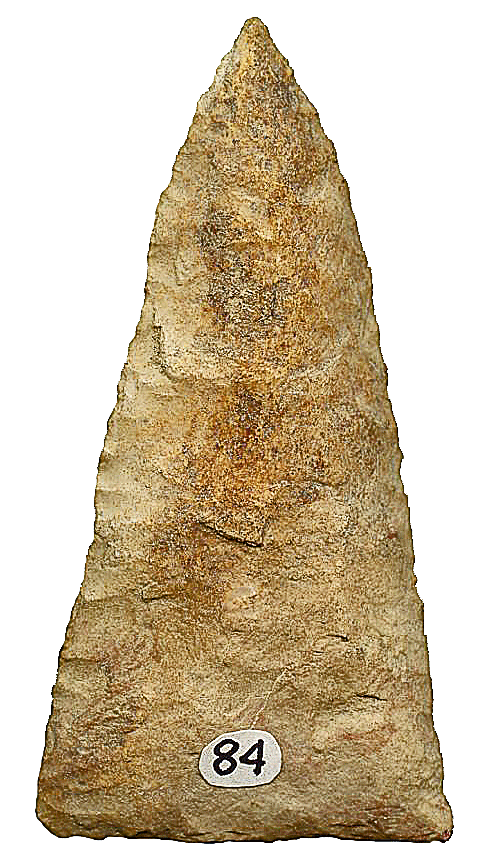



Point Type: MADISON
Also See: Camp Creek, Caraway, Clarksville,
Fresno, Guntersville, Hamilton Arrow
, Levanna, Maud, Matamoros, Morrow Mountain, Pinellas, Starr, Valina
Location: Eastern United States
Associated Dates:
1100 - 200 B.P. - Mississippian
Morphology: Lanceolate (Triangular)
General Description: The Madison is a small to medium sized, thin, triangular lanceolate arrowhead with either a straight (47 %) or slightly concave (53 %) base. These points are usually isosceles triangular in shape (about 80% of the time) or equilateral triangular in shape (about 20% of the time). The blade edges are usually straight (75 %) while excurvate (17 %) or incurvate (8 %) blade edges are also extant.
The point has wide distribution especially in New York, Connecticut, northern New Jersey, northeastern Pennsylvania, most of New England, Southern Ontario, and into the middle Atlantic states at least as far south as Florida. The type can be found as far west as the boarder of the Mississippi river. The point is made from local materials, flints, cherts, siltstones and quartzites. It is possible that some of the midwestern Madison points were preforms for the notched Cohokia type.
The length range of the Madison arrowhead is between 12 mm and 72 mm with the majority of specimens in the 26 mm range. The longer varieity of Madison is usually 1 1/2 times as long as wide. The Madison was named by Edward G. Scully in 1951 for specimens found in Madison County, Illinois. Scully first named the point the Mississippi Triangular Point but then changed the name to Madison. The Madison is a member of the Late Woodland/Mississippian Triangular Cluster of arrowheads. It is suspected that the Madison point type replaced the Levanna style in or about 1350 A.D.
About the Point Above (Left): The point pictured at the top of this page (distal end pointing up) is a large sized Madison arrowhead. This specimen is made from a black siltstone which is highly patinated and has the remains of lichen growth still attached to its surface. The point is well battered with two major chips out of the lower blade edge and one chip out of the upper blade edge. The point also shows signs of fire damage pock marking. The point is chipped off due to some historic impact fracture. The point measures 43 mm in length, 23 mm at the widest point (across the base) and is 7 mm thick mid blade. The point tip thins down to 2.5 mm in thickness and the basal edge thins to 4 mm in thickness. This point was a surface find at the edge of the parking lot of the old Housatonic Marina located at the end of Sniffen's Lane, on the shores of the Housatonic River, town of Stratford, Fairfield County, Connecticut. Catalog Number 53-2-B
About the Point Above (Right): The point pictured at the top right of this page (distal end pointing up) is a very large sized Madison arrowhead. This specimen is made from a grainy tan chert which is highly patinated and has been darkened with creek stain. The point also has a great quantity of surface calcification and encrustation possibly due to exposure to water. The point measures 70 mm in length, 41 mm at the widest point (across the base) and is 9 mm thick mid blade. The point tip thins down to 3.5 mm in thickness and the basal edge thins to 4 mm in thickness. This point was found in a creek in Ramar Tennessee. Catalog Number 84-30-D
References: Cambron & Hulse, Dragoo (f), Fogleman, Hranicky, Justice, Overstreet, Perino (1), Powell, Ritchie, Waldorf
© Copyright 1997 - 2008 LITHICS-Net WWW.LITHICSNET.COM
Use Your Browser's BACK Button to Return to the LITHICS-Net Index.